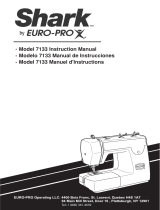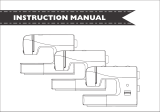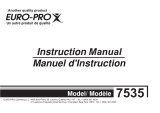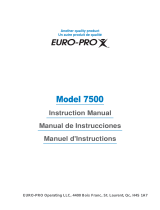Page is loading ...

iMPORTANT SAFETY iNSTRUCTiONS
When using an electrical appliance, basic
safety precautions should always be
followed, including the following:
Read all instructions before using this
sewing machine.
DANGER - To reduce the risk of
electric shock:
1. An appliance should never be left
unattended when plugged in.
2. Always unplug this appliance from the
electric outlet immediately after using
and before cleaning.
3. Always unplug before re-lamping.
Replace bulb with same type rated 10
watts (110-12eV area).
WARNING - Toreducetherisk
of burns, fire, electric shock, or injury
to persons:
1. Do not allow to be used as a toy
Close attention is necessary when
this appliance is used by or near
children.
2. Use this appliance only for its intended
use as described in this manual.
Use only attachments recommended
by the manufacturer as contained in
this manual.
3. Never operate this appliance if it has
a damaged cord or plug, if it is not
working properly, if it has been
dropped or damaged, or dropped into
water. Return the appliance to the
nearest authorized dealer or service
center for examination, repair,
electrical or mechanical adjustmenL
4. Never operate the appliance with any
air openings blocked. Keep ventilation
openings of the sewing machine and
foot controller free from accumulation
of lint, dust, and loose cloth.
5. Keep fingers away from all moving
parts. Special care is required around
the sewing machine needle
6. Always use the proper needle plate
The wrong plate can cause the needle
to break.
7. Do not use bent needles.
8. Do not pull or push fabric while stitching.
It may deflect the needle causing it to
break.
9. Switch the sewing machine off ("O")
when making any adjustments in the
needle area, such as threading needle,
changing needle, threading bobbin, or
changing presser foot, and the like.
10. Always unplug sewing machine from
the electrical outlet when removing
covers, lubricating, or when making
any other user servicing adjustments
mentioned in the instruction manual.
11. Never drop or insert any object into
any opening.
12 Do not use outdoors.
13. Do not operate where aerosol spray
products are being used or where
oxygen is being administered.
14. To disconnect, turn all controls to the
off ("O") position, then remove plug
from outlet
15 Do not unplug by pulling on cord. To
unplug, grasp the plug, not the cord.
16 The sound pressure level under normal
operating conditions is 75dB(A).
SAVE THESE
iNSTRUCTiONS
This sewing machine is intended for
household use only.
REV. 12/04

Congratulations
As the owner of a new EURO-PRO sewing machine, you wilt enjoy precision quality
stitching on all types of fabrics, from multiple layers of denim to delicate silks.
Your EURO-PRO sewing machine offers the ultimate in simplicity and ease of operation.
For your safety and to fully enjoy the many advantages and ease of operation of your
sewing machine, we recommend that you read all the important safeguards and use and
care instructions in this instruction book.
May we suggest that before you start to use your sewing machine, you discover the
many features and advantages by going through this instruction book, step by step, while
seated at your sewing machine.
Estimado Cliente
Le feticitamos muy cordiatmente por su nueva m#,quina de coser.
Yd. acaba de comprar un producto de catidad que ha sido fabricado con el maximo
cuidado. Su m_quina de coser es facil de usar pero naturatmente hay que seguir tas
regtas. Y estas tas hemos especificado en este manual de instrucciones. Si Vd. tes
presta atenci6n entonces reatizar#, sus trabajos perfectamente desde et comienzo.
Por supuesto que usted tendra atgunas preguntas que en este manual no hemos podido
responder en forma total. En tat caso acuda a nuestro representante o distribuidor
autorizado quien estara siempre a su disposici6n.
Le deseamos un buen trabajo con su m#,quina y que pueda dar rienda suetta a su
fantasia.
Felicitations
A titre de nouveau proprietaire d'une machine #, coudre EURO-PRO, vous pourrez
apprecier une couture de quatite sur tous tes genres de tissus, que ce soit ptusieurs
epaisseurs de denim ou de ta sole delicate.
Votre machine b,coudre EURO-PRO offre ce qu'it y a de mieux en fait de simpticite et de
facitite d'usage. Pour votre securit6 et afin de pteinement apprecier tes nombreux
avantages de votre machine b, coudre, nous recommandons que vous tisiez toutes tes
mesures de securit6 et tes instructions qui sont contenues dans te present manuel.
Permettez-nous de vous suggerer, avant d'utiliser votre machine b,coudre, de decouvrir
tes nombreuses caracteristiques et avantages en feuittetant ce manuel, etape par etape,
assise face a votre machine a coudre.

List of contents
Principal parts ................................................................................................................. 2/4
Accessories ........................................................................................................................ 6
Fitting the snap-in sewing table .......................................................................................... 8
Connecting machine to power source .............................................................................. 10
Changing the butb ............................................................................................................ 12
Two-step presser foot lever/Adjusting the presser foot pressure .................................... 14
Attaching the presser foot holder ..................................................................................... 16
Winding the bobbin .......................................................................................................... 18
Inserting bobbin ................................................................................................................ 20
Changing the needle (system 130/705H) ........................................................................ 22
Threading the upper thread .............................................................................................. 24
Automatic needle threader ............................................................................................... 26
Thread tension ................................................................................................................. 28
Bringing up the lower thread ............................................................................................ 30
Reverse sewing / Changing sewing directions ................................................................. 32
Removing the work / Cutting the thread ........................................................................... 34
How to drop feed dog ....................................................................................................... 36
Matching needle / fabric / thread ...................................................................................... 37
How to choose your pattern ............................................................................................. 40
LCD (Liquid crystal display) ............................................................................................. 42
General instructions of LCD ........................................................................................ 44/45
Straight stitching and needle position .............................................................................. 46
Zig zag sewing ................................................................................................................. 48
Blind hem/lingerie stitch .................................................................................................. 50
Overtock stitches .............................................................................................................. 52
Sewing on buttons ............................................................................................................ 54
How to sew buttonholes (one-step buttonhole) ................................................................ 56
Left and right side balance for buttonhole ........................................................................ 58
Zippers and piping ............................................................................................................ 60
Sewing with the hemmer foot ........................................................................................... 62
3-step zig-zag ................................................................................................................... 63
Stitch selection ................................................................................................................. 66
Smocking stitch ................................................................................................................ 68
Sewing with the cording foot ............................................................................................ 70
Free motion darning ......................................................................................................... 72
Practical stitches .............................................................................................................. 74
Darning ............................................................................................................................. 76
Attaching lace ................................................................................................................... 78
Applique ........................................................................................................................... 80
Twin needle ...................................................................................................................... 82
Monogramming and embroidering with embroidery hoop*. ............................................. 84
Quilting ............................................................................................................................. 86
Gathering ......................................................................................................................... 88
Scallop stitching ............................................................................................................... 90
Patch work ....................................................................................................................... 92
The walking foot accessory .............................................................................................. 94
Maintenance ..................................................................................................................... 96
Trouble shooting guide ..................................................................................................... 98

Principal parts
1. Thread tension dial
2. Presser foot pressure
3. Thread take-up lever
4. Thread cutting
5. Presser foot
6. Needle plate
7. Sewing table and accessory box
8. Bobbin stopper
9. Stitch length dial
10. Stitch width dial
11. LCD (Liquid crystat display)
12. Reverse sewing lever
13. Drop feed control
14. One step buttonhole lever
15. Automatic threader
1
2
3
10
11
12
14
15

Principal parts
18. Handle
19. Bobbin winder
20. Spool pin
21. Handwheel
22. Pattern selector dial
23. Power switch
24. Main plug socket
25. Bobbin thread guide
26. Upper thread guide
27. Presser foot lever
28. Buttonhole stitch balance adjustment slot
18
19
20
21
25
26
27
23
24

(_Accessories
Standard Accessories (1)
1. All purpose foot _}
2. Zipper foot
3. Button sewing foot
4. Buttonhole foot @
5. Blind hem foot
6. L-screwdriver
7. Seam ripper/brush
8. Oil bottle
9. Packof needles (3x)
10. Bobbin (3x)
11. Seam guide
12. Spool pin felt (2x)
Bonus Feet (2)
13. Overlock foot @
14. Satin stitch foot
15. Darning/Embroidery foot
16. Cording foot
17. Quilting foot
18. Gathering foot
19. Roll hemming foot
Optional Accessories (3)
These accessories are not
supplied with this sewing
machine;they are however
available as special
accessories by calling our
customer service at
1 (800) 361-4639.
20. Walking foot
21. Twin needle
* Feet _) , _), _i_ , !:_ These letters appear on the electronic display.
6 7

Fitting the snap=in sewing table
Hold the snap-in sewing table horizontal, and push it
in the direction of the arrow. (1)
The inside ofthe snap-in sewing table can be utilized
as an accessory box.
To open, tift up at the point of the arrow. (2)

Connecting machine to power source
[] Caution:
Always make sure that the machine is unplugged from power source
and the main switch is on "O't when the machine is not in use and
before inserting or removing parts.
B
r
- This machine is equipped with a polarized plug which must be used
with an appropriate electrical outlet.
- Connect the machine to a power source as illustrated (1/2).
- The power switch is located above the terminal box. Your machine
will not operate unless this switch is on " I". (1)
- Sewing light turns on automatically when the main switch is on " I ".
- To start the machine, press on the foot control (4). The speed of
the machine is regulated by the amount of pressure exerted on the
foot control.
[] Attention:
Coneu/t a qua//f/ed e/ectr/c/an if in doubt as to connect machine to
power source. Unplug power cord when machine is not in use.
The appliance must be used with the foot controller 4C337B (110-
t20V area) / 4C-337G (220-240V area) manufactured by
MA TSUSHITA ELECTRIC (TAIWAN) CO., LTD.
IMPORTANT NOTICE
For appliance with a polarized plug (one blade is wider than the other).
To reduce the risk of electric shock, this plug is intended to fit in a
polarized outlet only one way. If it does not fit fully in the outlet,
reverse the plug. If it still does not fit, contact a qualified electrician to
install the proper outlet. Do not modify the plug in any way. (3)
a, Polarized attachment plug
b. Conductor intended to be grounded
10

Changing the bulb
te Caution:
Make sure to disconnect the electrical supply plug
from wall outlet before changing light bulb.
Replace butb with same type rated 10 watts (110-
120V area) or 15 watts (220-240V area).
- Loosen screw (A) as illustrated. (1)
- Remove the cover (B).
- Unscrew the bulb and fit new one (C). (2)
- Replace the cover and tighten screw.
12

Two=step presser foot lever
When sewing several layers or thick fabrics, the
presser foot can be raised a second stage for easy
positioning of the work. (A)
Adjusting the presser foot pressure
The presser foot pressure of the machine has been
pre-set and requires no particular readjustment
according to the type of fabric (tight-or-heavy weight).
However, if you need to adjust the presser foot
pressure, turn the presser adjusting screw with a coin.
For sewing very thin fabric, loosen the pressure by
turning the screw counter clockwise, and for heavy
fabric, tighten by turning it clockwise.
14

Attaching the presser foot holder
m Attention:
Turn power switch to "0" before carrying out any of the
operations below.
Raise the needle to its highest position and raise the
presser foot lever. Attach the presser foot holder (b) to
the presser foot bar (a). (1)
e '_
Attaching the presser foot:
Lower the presser foot holder (b) until the cut-out (c) is
directly above the pin (d). (2)
Lower the presser foot holder (b) and the presser foot (f)
wilt engage automatically.
Removing the presser foot:
Raise the presser foot.
Release the pressure foot by raising lever (e) located at
the back of the foot holder. (3)
Attaching the seam guide:
Attach the seam guide (g) in the slot as illustrated. Adjust
the distance as required for hems, pleats, etc.... (4)
16

Winding the bobbin
Press the foot control gently. The bobbin will stop winding
the left to "sewing position" and remove it.
#aPlease Note:
When the bobbin winder spindle/#//7
"bobb/h winding" pos/tion, the machine
wi// not sew and the hand wheel w/Y/
not turn. To start sewing, push the
bobbin winder spindle to the left
(sewing position).
a. Spool pin felt
Place an empty bobbin on the
bobbin winder spindle.
Take the thread from the spool
through the bobbin winder
tension disc. (1)
Wind the thread a few times by
hand around the empty bobbin in
a clockwise direction. Push the
bobbin to the right towards the
bobbin winding position. (2)
when it is full. Push the bobbin to
18

inserting bobbin
[] Attention:
Turn power switch to "0" before inserting or removing the
bobbin.
When inserting or removing the bobbin, the needle must be
fully raised.
- Open the hinged cover. (1)
Hold the bobbin case with one hand. Insert the bobbin so
that the thread runs in a clockwise direction (arrow). (2)
Putl the thread through the slot, down and to the left until it
enters the delivery eyelet (rectangular opening) under the
tension spring. (3)
Hold the bobbin case by the hinged latch. (4)
Insert the bobbin case fully into the shuttle race and release
the latch. Make sure that the metal finger fits into the notch
at the top of the race cover. (5)
2O

Changing the needle (System 130/705H)
t_ Caution:
Turn power switch to "0" before
inserting or removing the need/e.
Replace the needle at the first sign of
thread breakage or skipped stitches.
Select the correct type and size of
needle for the fabric to be sewn. Turn
the balance wheel towards you until
the needle is at highest position.
Loosen the needle clamp screw (A)
and tighten again after inserting the
new needle. (1)
The flat side of the needle shaft
should be facing away from you (B).
Push the needle up (C) into the
needle clamp as far as it wilt go (D).
Tighten the needle clamp screw firmly.
The sewing needle must always be
straight and sharp for smooth sewing.
Replace the needle (2) if it is bent (A),
blunt (B) or the point is damaged (C).
22

Threading the upper thread
m Caution:
Before threading, turn
power switch to "0".
Raise the needle bar to
its highest position.
Follow exactly the
numbered threading
sequence illustrated
below. If you skip a step
or fail to properly engage
the thread in any of the
thread guides, the
machine wilt not sew
properly. (1-5)
Continue to draw the
thread down and into the
needle bar thread guide.
Insert the thread through
the eye of the needle
from front to back. Leave
about 10 cm (4") of
thread loose behind the
needle. (6)
@
a. Spool pin felt
24

Automatic needle threader
- Raise the needle to its highest
position.
- Press lever (A) right down.
-The threader automatically
swings to the threading
position (B).
-Take the thread around the
hook (C).
- Take the thread in front of the
needle round the hook (D)
from bottom to top.
- Release lever (A).
-Putt the thread through the
needle eye.
Attention:
Turn power switch to off ("0")/
26

Thread tension
t_ Note:
The bobbin thread tension has
been adjusted at the factory and
readjustment is usua//y not
required
Lower thread tension
To test the bobbin thread
tension, remove the bobbin case
and bobbin from the machine
and hold the bobbin case
suspended by the thread. Shake
it once or twice. If the tension is
correct, the thread witt unwind
by about an inch or two. If the
tension is too tight, it wilt not
unwind. If the tension is too
loose, the thread wilt unwind for
more than two inches.
To adjust, turn the small screw
on the side of the bobbin case.
(1)
Upper thread tension
Basic thread tension setting: "4". (2)
To increase the tension, turn the dial up to a higher number. To reduce the tension, turn
the dial to a lower number.
A. Normal thread tension.
B. Thread tension too loose.
C. Thread tension too tight.
28

Bringing up the lower thread
Hold the upper thread with the left
hand. Turn the handwheet towards
you with your right hand until the
needle goes down and comes up
again to its highest position. (1)
-Lightly draw the needle thread
forming a loop with the bobbin
thread. The upper thread should
have caught the lower thread in a
loop.
-Putt the needle thread toward you
and the lower thread wilt come up
from the bobbin in a large loop. (2)
Putt about 15 cm. (6") of both thread
away from you under the presser
foot.
3O

Reverse sewing
Reverse sewing is used for locking the end of seams
and where reinforcement is needed. At the end of seam,
press down the reverse sewing lever and touch the foot
control lightly. Sew a few reverse stitches. Release the
lever and the machine wilt sew forwards again (A).
Changing sewing directions
1. Stop the machine at the point where you wish to
change directions with the needle still in the fabric.
2. Raise the presser foot and turn the fabric to line up its
new direction using the needle as a turning point.
3. Lower the presser foot and start sewing in the new
direction.
32

Removing the work
Turn the handwheel towards you to bring the thread take
up lever to its highest position. Raise the presser foot
and draw the fabric away from you.
Cutting the thread
Hold the threads behind the presser foot. Using both
hands, guide them to the slit at the rear of the presser
bar and press down to cut the thread. You can also use
the thread cutter (A) on the side of the machine.
\
34
/





